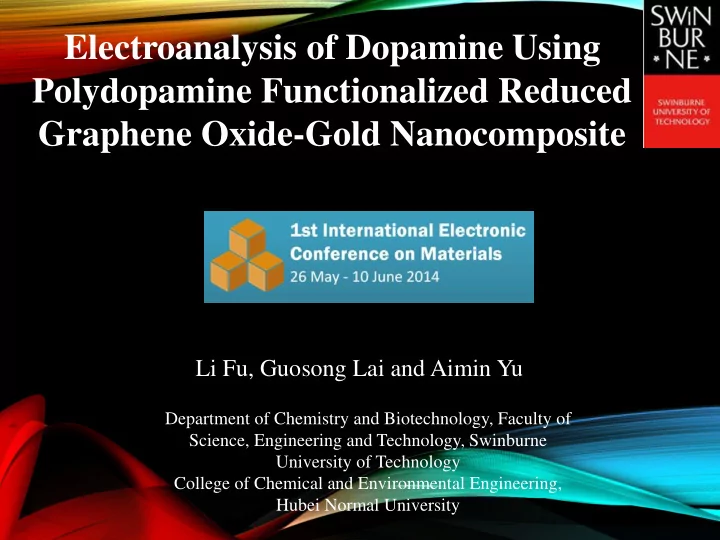

Electroanalysis of Dopamine Using Polydopamine Functionalized Reduced Graphene Oxide-Gold Nanocomposite Li Fu, Guosong Lai and Aimin Yu Department of Chemistry and Biotechnology, Faculty of Science, Engineering and Technology, Swinburne University of Technology College of Chemical and Environmental Engineering, Hubei Normal University
OUTLINE • Introduction • Method • Characterizations • Determination of Dopamine • Summary
Introduction Graphene • Two-dimensional monolayer of graphite • Extraordinary mechanical strength, large specific surface area and high conductivity • Excellent platform for loading nanoparticles
Introduction Why Polydopamine and Gold ? • Reduce agent for reduction of • Improved the electronic conductivity • Increase surface area for grapheme oxide • Increase dispersity of reduced electrocatalytic activity grapheme oxide
Method PDA-RGO nanocomposite: Dopamine self-polymerization in Tris-buffer for 24 h PDA-RGO/Au nanocomposite: Electrodeposition
Characterizations • FTIR spectra confirmed the successful functionalization of PDA • FTIR also confirmed the reduction of GO • UV-vis spectra confirmed the reduction of GO
Morphology
Electrochemical Behavior Towards Oxidation of DA • PDA-RGO/Au modified electrode showed the best electrocatalytic performance towards oxidation of DA
Linear Sweep Voltammograms for DA Determination • The oxidation peak currents showed a linear relationship with DA concentrations from 0.05-1 mM. • Linear regression equation: as Ipa (μA) = 9.8684 c (mM) + 2.2215
Selectivity • Excellent selectivity towards oxidation of DA
Summary • PDA-RGO/Au nanocomposites were prepared via wet chemical method combined with electrodeposition • FTIR and UV-vis spectroscopy confirmed the reduction of GO and PDA surface functionalization • PDA-RGO/Au modified GCE exhibits an excellent electrocatalytic activity towards oxidation of DA.
Recommend
More recommend